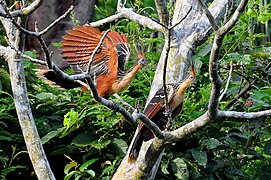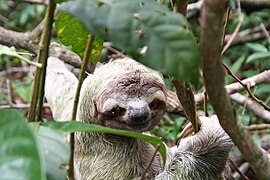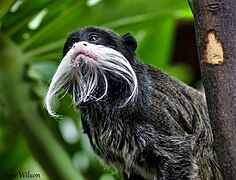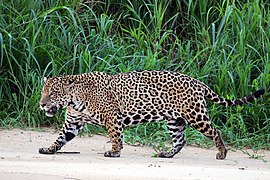अमेजन जंगल
| अमेज़न वर्षावन पुर्तगाली: Floresta amazônica स्पेनी: Selva amazónica | |
|---|---|
 ब्राजील के मानौस के नगीचे के एगो सीन | |
| Geography | |
 वल्ड वाइड फंड फॉर नेचर संस्था द्वारा सीमांकन कइल नक्शा। पियरकी लाइन मोटा-मोटी अमेजन के बहाव बेसिन के देखावत बाटे। देसन के सीमा के करिया लाइन से देखावल गइल बा। (उपग्रह से लिहल फोटो नासा के सौजन्य से) | |
| Location | ब्राज़ील, पेरू, कोलंबिया, वेनेजुएला, इक्वेडोर, बोलीविया, गयाना, सूरीनाम, फ्रांस (फ्रेंच गयाना) |
| Coordinates | निर्देशांक: 3°S 60°W / 3°S 60°W |
| Area | 5,500,000 किमी2 (5.9×1013 वर्ग फु) |
अमेज़न के बरसाती बन भा अमेजन जंगल (अंग्रेजी: Amazon rainforest, अमॆजोन रेनफ़ॉरॆस्ट) दक्खिन अमेरिका के ब्राजील आ आसपास के देसन में मौजूद चाकरपतई वाले आ उष्ण कटिबंधी नम जलवायु वाले बरसाती बन हवें। ई अमेजन नदी के बेसिन में बिस्तार लिहले बाड़ें जेकरा चलते इनहन के ई नाँव पड़ल हवे। अंग्रेजी में इनहन के अमेजन रेनफारेस्ट भा अमेजोनिया भी कहल जाला। अमेजन बेसिन के बिस्तार लगभग 7,000,000 किमी2 (2,700,000 वर्ग मील) रकबा पर बाटे आ एकर करीबन 5,500,000 किमी2 (2,100,000 वर्ग मील) इलाका एह बरसाती बन सभ वाला बाटे। ई इलाका कुल नौ गो देसन के सीमा में बिस्तार लिहले बाटे।
एह बरसाती बन के जादेतर हिस्सा ब्राजील देस में पड़े ला, लगभग 60% हिस्सा एही देस में बाटे, एकरे बाद पेरू देस में एकर लगभग 13% हिस्सा, कोलंबिया में 10%, आ बाकी के हिस्सा वेनेजुएला, इक्वेडोर, बोलीविया, गयाना, सूरीनाम आ फ्रांस (फ्रेंच गयाना) में बाटे। चार गो देसन में एह बन सभ खातिर "अमेजोनास" नाँव से पहिला-स्तर के प्रशासनिक बिभाग (प्रांत) बाड़ें। अमेजन के ई जंगल पूरा दुनिया में बचल बरसाती बन सभ के लगभग आधा हिस्सा बाड़ें।[1] बरखाबन के सभसे बेसी एक साथ बिस्तार वाला ई जंगल सभसे बेसी जीवबिबिधता वाला बरखाबन हवे जहाँ एस्टीमेट के मोताबिल 390 बिलियन पेड़ बाने आ ई लगभग 16,000 प्रजातिन के बाड़ें।[2]
2019 में ब्राजील के एह जंगल सभ में भारी जंगल के आग के खबर दुनिया के सोझा आइल जब इहाँ के अंतरिक्ष रिसर्च के नेशनल इन्स्टीट्यूट (Instituto Nacional de Pesquisas Espaciais – INPE) द्वारा जानकारी दिहल गइल कि कम से कम 75,336 जंगल के आग के घटना एह साल जनवरी से अगस्त 2019 ले हो चुकल बाड़ी स, ई अबतक के रिकार्ड सभसे बेसी संख्या बाटे जबसे 2013 आइएनपीई अइसन डेटा एकट्ठा क रहल बाटे।[3][4] ई आँकड़ा सैटेलाईट से लिहल तस्वीर सभ के सहारे एकट्ठा कइल जाला।[5] धियान देवे के बात ई बा इ एह जंगल सभ के "पृथ्वी के फेफड़ा" नाँव दिहल जाला।[6]
जीवबिबिधता
[संपादन करीं]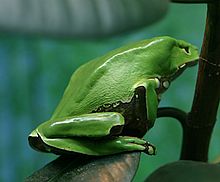
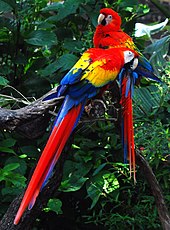
नम उष्णकटिबंधी बन सभ के बिसेसता हवे की ई सभसे बेसी जीवबिबिधता वाला बायोम हवें। इहो उल्लेख के बात बा कि एशिया आ अफिरका में पावल जाए वाला अइसन बन सभ के तुलना में दक्खिन अमेरिका के ई अमेजन बन में बेसी जीव बिबिधता पावल जाले।[7] एगो सोलहग एतना बिस्तृत बन होखे के कारण एह जंगल सभ के जीवबिबिधता दुनिया में अपने-आप में सभसे बेसी बा जवना के तुलना अउरी कहीं से ना हो सके ला। दुनिया में जेतना प्रजाति सभ के जानकारी बाटे, दस में से एक प्रजाति इहाँ मिले ला।[8] एह तरीका से ई बायोम दुनिया के सभसे बिबिध प्रजाति सभ के इलाका बन जाला।
एह इलाका में 25 लाख प्राजाति के कीड़ा-मकोड़ा (इन्सेक्ट) पावल जालें,[9] दसन हजार किसिम के फेड़ पावल जालें, 2,000 से बेसी प्रजाति के चिरई आ मैमल आ दू हजार से बेसी प्रजाति के मछरी पावल जालीं।[10] 1,294 birds, 427 mammals, 428 amphibians, and 378 reptiles have been scientifically classified in the region.[11] दुनिया के एक बटा पाँच किसिम के चिरई सभ एही जंगल में पावल जाली लगभग एतने, मने कि पाँच में एक, किसिम के मछरी अमेजन के सहायक नदी आ एह नदी में पावल जालीं। बैज्ञानिक लोग 96,660 से 128,843 गो इन्वर्टीब्रेट सभ के प्रजाति के जानकारी अकेल्ले ब्राजील में बतवले बा।[12]
The biodiversity of plant species is the highest on Earth with one 2001 study finding a quarter square kilometer (62 acres) of Ecuadorian rainforest supports more than 1,100 tree species.[13] A study in 1999 found one square kilometer (247 acres) of Amazon rainforest can contain about 90,790 tonnes of living plants. The average plant biomass is estimated at 356 ± 47 tonnes per hectare.[14] To date, an estimated 438,000 species of plants of economic and social interest have been registered in the region with many more remaining to be discovered or catalogued.[15] The total number of tree species in the region is estimated at 16,000.[2]
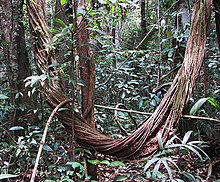
The green leaf area of plants and trees in the rainforest varies by about 25% as a result of seasonal changes. Leaves expand during the dry season when sunlight is at a maximum, then undergo abscission in the cloudy wet season. These changes provide a balance of carbon between photosynthesis and respiration.[16]
The rainforest contains several species that can pose a hazard. Among the largest predatory creatures are the black caiman, jaguar, cougar, and anaconda. In the river, electric eels can produce an electric shock that can stun or kill, while piranha are known to bite and injure humans.[17] Various species of poison dart frogs secrete lipophilic alkaloid toxins through their flesh. There are also numerous parasites and disease vectors. Vampire bats dwell in the rainforest and can spread the rabies virus.[18] Malaria, yellow fever and Dengue fever can also be contracted in the Amazon region.
-
Bullet ants have an extremely painful sting
-
Parrots at clay lick in Yasuni National Park, Ecuador
संदर्भ
[संपादन करीं]- ↑ "WNF: Places: Amazon". Retrieved 4 June 2016.
- ↑ 2.0 2.1 "Field Museum scientists estimate 16,000 tree species in the Amazon". Field Museum. 17 अक्टूबर 2013. Archived from the original on 2019-12-07. Retrieved 18 अक्टूबर 2013.
- ↑ "'Record number of fires' in Brazilian rainforest". BBC News Online. BBC Online. बीबीसी. 21 अगस्त 2019. Retrieved 21 अगस्त 2019.
- ↑ Rodriguez, Jeremiah (22 अगस्त 2019). "As the Amazon burns, Brazil's president draws global outrage". CTV News. Retrieved 22 अगस्त 2019.
- ↑ Andreoni, Manuela; Hauser, Christine (21 अगस्त 2019). "Fires in Amazon Rain Forest Have Surged This Year". दि न्यूयॉर्क टाइम्स. Rio de Janeiro. Retrieved 21 अगस्त 2019.
- ↑ "Amazon: Lungs of the planet". www.bbc.com (अंग्रेजी में). बीबीसी. Retrieved 23 अगस्त 2019.
- ↑ Turner, I.M. 2001. The ecology of trees in the tropical rain forest. कैंब्रिज युनिवर्सिटी प्रेस, कैंब्रिज. ISBN 0-521-80183-4
- ↑ "Amazon Rainforest, Amazon Plants, Amazon River Animals". वल्ड वाइड फंड फॉर नेचर. Archived from the original on 17 May 2008. Retrieved 6 May 2008.
{{cite web}}: Unknown parameter|deadurl=ignored (help) - ↑ "Photos / Pictures of the Amazon Rainforest". Travel.mongabay.com. Archived from the original on 17 December 2008. Retrieved 18 December 2008.
{{cite web}}: Unknown parameter|deadurl=ignored (help) - ↑ James S. Albert; Roberto E. Reis (8 March 2011). Historical Biogeography of Neotropical Freshwater Fishes. University of California Press. p. 308. Archived from the original on 30 June 2011. Retrieved 28 June 2011.
{{cite book}}: Unknown parameter|deadurl=ignored (help) - ↑ Da Silva; Jose Maria Cardoso; et al. (2005). "The Fate of the Amazonian Areas of Endemism". Conservation Biology. 19 (3): 689–694. doi:10.1111/j.1523-1739.2005.00705.x.
- ↑ Lewinsohn, Thomas M.; Paulo Inácio Prado (June 2005). "How Many Species Are There in Brazil?". Conservation Biology. 19 (3): 619–624. doi:10.1111/j.1523-1739.2005.00680.x.
- ↑ Wright, S. Joseph (12 October 2001). "Plant diversity in tropical forests: a review of mechanisms of species coexistence". Oecologia. 130 (1): 1–14. Bibcode:2002Oecol.130....1W. doi:10.1007/s004420100809. PMID 28547014.
- ↑ Laurance, William F.; Fearnside, Philip M.; Laurance, Susan G.; Delamonica, Patricia; Lovejoy, Thomas E.; Rankin-de Merona, Judy M.; Chambers, Jeffrey Q.; Gascon, Claude (14 June 1999). "Relationship between soils and Amazon forest biomass: a landscape-scale study". Forest Ecology and Management. 118 (1–3): 127–138. doi:10.1016/S0378-1127(98)00494-0.
- ↑ "Amazon Rainforest". South AmericaTravel Guide. Archived from the original on अगस्त 12, 2008. Retrieved अगस्त 19, 2008.
{{cite web}}: Unknown parameter|deadurl=ignored (help) - ↑ Mynenia, Ranga B.; et al. (13 March 2007). "Large seasonal swings in leaf area of Amazon rainforests". Proceedings of the National Academy of Sciences. 104 (12): 4820–4823. Bibcode:2007PNAS..104.4820M. doi:10.1073/pnas.0611338104. PMC 1820882. PMID 17360360.
- ↑ "Piranha 'less deadly than feared'". BBC News. 2 July 2007. Archived from the original on 7 July 2007. Retrieved 2 July 2007.
{{cite news}}: Unknown parameter|deadurl=ignored (help) - ↑ da Rosa; Elizabeth S. T.; et al. (August 2006). "Bat-transmitted Human Rabies Outbreaks, Brazilian Amazon". Emerging Infectious Diseases. 12 (8): 1197–1202. doi:10.3201/eid1708.050929. PMC 3291204. PMID 16965697.
| ई भूगोल-संबंधित लेख एगो आधार बाटे। जानकारी जोड़ के एकरा के बढ़ावे में विकिपीडिया के मदद करीं। |
| ई दक्खिन अमेरिका के अस्थान या भूगोल से संबंधित लेख एगो आधार बाटे। जानकारी जोड़ के एकरा के बढ़ावे में विकिपीडिया के मदद करीं। |

